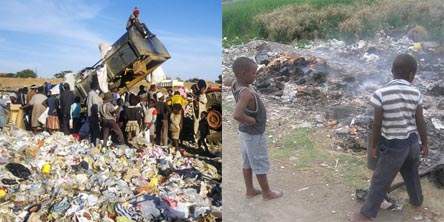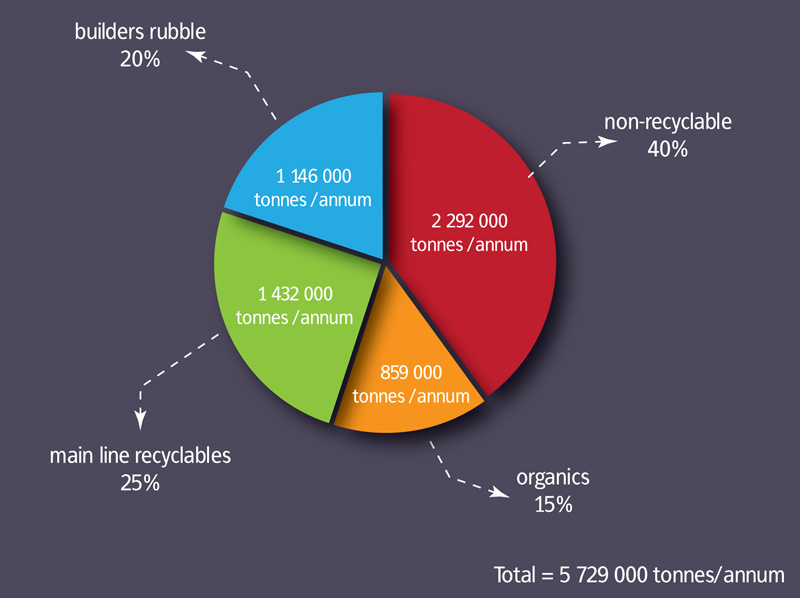|
| the more we waste, the more we’ll want |
 |
DID YOU KNOW
- Waste-to-landfills can be reduced by 60% (3 885 702 tons/year)
- 19 400 jobs can be created
- Gauteng is the largest waste producer in South Africa
- We produce more than 5.7-million tons of waste/year
- The average amount of waste generated in Johannesburg is about 1.2 kg/person/day.
|
|
| |
in Gauteng… |
- increasing urbanisation is leading to increasing waste generation
- increasing commercial and industrial development is translating into more waste being generated by the residential, industrial and commercial sectors
- there is limited waste collection in poor areas. Twenty percent of households within the Gauteng province do not have access to weekly refuse removal services
- there is poor enforcement of national, provincial and municipal laws and regulations
- there is a lack of encouragement and awareness of waste avoidance, minimisation and recycling
- the rising oil price is increasing the cost of waste transportation to landfills.
|
leaving us with… |
- pollutants entering the surface or groundwater resources, air and soil
- leachate generation, odours, noxious airborne emissions (volatile organic compounds) from mismanaged landfill and dump sites, as well as incineration and illegal burning
- landfills attract vermin and harbour disease spreading vectors that pose health risks
- littering and illegal dumping can lead to urban decay
- reduced biological diversity in the areas of waste management operation as a result of land disturbance and effects of emissions and discharges from waste facilities
- negative societal impacts of inadequate service provision in the form of illegal dumping, littering and abuse of open spaces
- increased health risks associated with inadequate waste collection and disposal services coupled with informal salvaging on landfill sites
- reduced recreational value of land and water resources and associated reduction in tourism and investment potential.
A waste stream analysis for municipalities in Gauteng reveals that of the total waste composition, only 40% cannot be recycled. This means that 60% can be recycled. This is made up as follows: |
| Gauteng waste stream composition |

|
| Gauteng Department of Agriculture and Rural Development, General Waste Minimisation Plan for Gauteng, July 2009, p15 |
what can we do to improve the situation? |
- Mandatory recycling
- By 2020 it is estimated that 6 520 076 t/annum of waste will be produced and that 3 885 702 t/annum could be recovered through recycling initiatives (GDACE, 2008).
This represents 60% of the projected volumes of waste for the long-term planning horizon thus indicating the positive effect that reuse, reduction and recycling can have on waste minimisation.
- Informal reclamation of recyclable waste under unhealthy and unsafe conditions on landfill sites is the only form of recycling currently undertaken in many areas (Metsweding District Municipality (2005) 'Inerated Waste Management Plan (IWMP)').
- Currently recycling is done on a voluntary basis, but the province plans to formalise efforts to ensure that separation at source becomes mandatory.
- By formalising these initiatives, the amount of waste sent to landfills will be reduced which will ultimately save in high disposal costs. In many areas construction and demolition waste is disposed of at landfill sites. These products would serve a greater purpose through recycling initiatives whereby demolition and construction waste is recycled to produce building materials (GDACE, 2008).
- Development of composting initiatives
- Currently organic waste is disposed of in landfill sites which occupies limited valuable landfill space (Ekurhuleni Metropolitan Municipality (2005) 'Inerated Waste Management Plan (IWMP)'). There is a general lack of collection/composting facilities for organic waste throughout the province. This presents an ideal opportunity to begin initiatives such as composting whereby organic waste can be reused to create a useful product.
- This can be tied in with local food production.
- Waste minimisation clubs
- This refers to initiatives where businesses in a particular geographic area group together to negotiate better terms or services from waste contractors (GDACE, 2006a). The club may also share facilities and equipment and exchange waste items that may be of use to another business (GDACE, 2006a). These initiatives can eventually lead to waste minimization efforts being instigated.
- Waste to energy
- The conversion of municipal solid waste to energy as an alternative energy is considered a viable option to generate clean energy.
- There are developers already investigating such projects under the proposed Feed-In Tariffs. These developers should be supported in their initiatives.
- Green procurement
- Green procurement is rooted in the principle of pollution prevention, and generally involves products that are easily recycled, last longer or produce less waste (GDACE, 2006a). If all levels of government follow the principles of green procurement it will have positive repercussions in industry as their suppliers will need to follow the principles of green procurement. Furthermore, municipalities can offer the benefit of green procurement to the general public.
- Multi-faceted landfill sites
- Landfills take up a large amount of valuable land, thus these sites need to become multi-faceted to ensure efficient use of all land resources. These sites provide an ideal opportunity for Eco-Parks, landscape design features and educational facilities in terms of their end uses.
- Landfill site selection will need to be optimised such that rail can be used to move the waste to the site and thus reduce transportation costs.
|
| |
|



